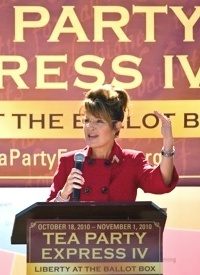
On Tuesday night, NBC’s David Gregory called the Tea Party “the elephant in the room.” MSNBC.com reported about that elephant on November 3, “What exit polls say about the Tea Party movement.”
An important national factor in House races, the Tea Party gave a shot in the arm to Republicans in some districts, but whether voters see “conservative” and “Tea Party” as interchangeable labels remains uncertain.
MSNBC reported exit poll data from Indiana, Pennsylvania, Wisconsin, and Missouri, but did not say if those states were the only ones in which exit polls were conducted, or what questions were asked.
When viewed as a percentage of the total electorate. Tea Party supporters ranged from a high of 47 percent in Texas to a low of 32 percent in California. They voted primarily Republican.
Almost all of Tea Party Republicans think the government is way too intrusive, with 92 percent wanting ObamaCare repealed, and two thirds saying that the economic stimulus hurt America. Non-Tea Party Republicans have similar views but with less intensity, however, the Tea Party movement doesn’t have the negative image that’s associated with the Republican Party. Thirty-one percent of voters said they oppose the movement, but 53 percent thought unfavorably of the GOP.
Polls indicated that in House races, 41 percent of those voting supported the Tea Party, with 31 percent opposing it. Twenty five percent had no opinion.
Forty-five percent of voters interviewed in Indiana polls said they supported the Tea Party. The majority of those said they voted for Republican Dan Coats who picked up a Democratic-held Senate seat. Coats isn’t considered a typical grassroots constitutionalist, but to Indianans was a better choice than Brad Elsworth, (D).
Tea Partiers accounted for 39 percent of the electorate in Pennsylvania, and 89 percent of them backed Republican Pat Toomey. Toomey defeated Democrat Joe Sestak, and more closely aligns with the perceived Tea Party ideal: a fiscal conservative in favor of small government and low taxes.
Wisconsin and Missouri had almost identical results. NBC News projected a win for Wisconsin conservative Ron Johnson over Russ Feingold (D), where Tea Partiers claimed about 36 percent of the electorate. NBC also projected Missourian Republican Roy Blunt to take the Senate seat over Robin Carnahan (D).
Like Coats, Blunt isn’t the Tea Party ideal. He backed the 2008 TARP program, which goes against the limited government stance adopted by Tea Partiers.
MSNBC included in its article snapshots of Americans aligning with the Tea Party. They were as varied as the rainbow: an Indiana vintner, a Pennsylvania steel salesman/volunteer policeman, an 18-year-old Bethany college student, and 86-year-old Christine Murdoch who still scuba dives. Also interviewed was a black FedEx driver who was a highlighted speaker at a recent rally against ObamaCare. He said race is beside the point. His government has failed him, and he said Obama’s election was the saddest day of his life.
They come from Democrat, Republican, and no-interest-in-politics backgrounds with more than a few things in common. All want limited government, lower taxes, accountable politicians and a voice in government.
Photo: Sarah Palin at a Tea Party rally in Reno, Nev. on October 18: AP Images



